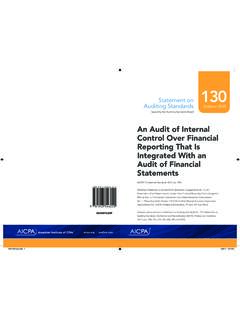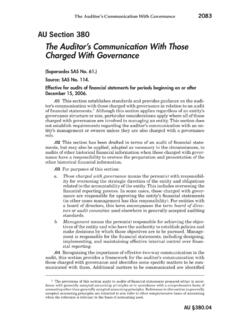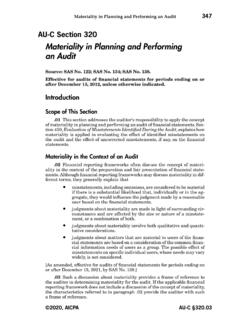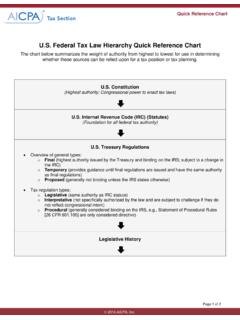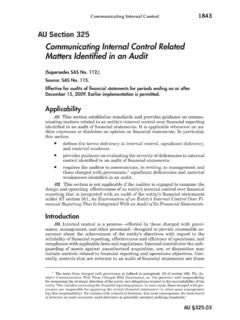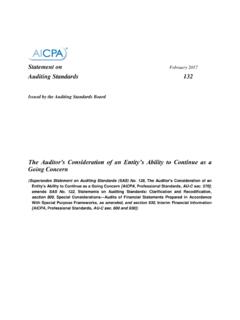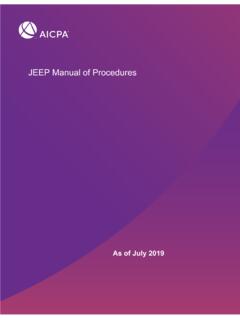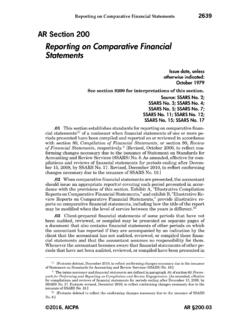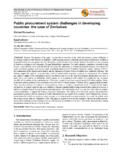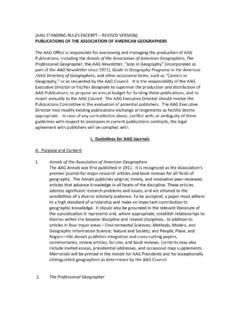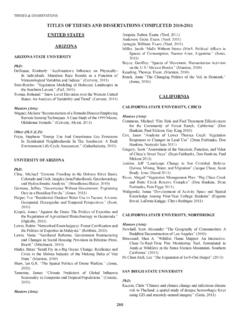Transcription of Audit Sampling - AICPA
1 Audit Sampling2067AU Section 350 Audit Sampling (Supersedes SAS No. 1, sections 320A and 320B.)Source: SAS No. 39; SAS No. 43; SAS No. 45; SAS No. section 9350 for interpretations of this for periods ended on or after June 25, 1983, unless Sampling is the application of an Audit procedure to less than 100percent of the items within an account balance or class of transactions for thepurpose of evaluating some characteristic of the balance or sectionprovides guidance for planning, performing, and evaluating Audit auditor often is aware of account balances and transactions thatmay be more likely to contain considers this knowledgein planning his procedures .
2 Including Audit Sampling . The auditor usually willhave no special knowledge about other account balances and transactions that,in his judgment, will need to be tested to fulfill his Audit objectives. Auditsampling is especially useful in these are two general approaches to Audit Sampling : nonstatisticaland statistical. Both approaches require that the auditor use professional judg-ment in planning, performing, and evaluating a sample and in relating theaudit evidence produced by the sample to other Audit evidence when forminga conclusion about the related account balance or class of transactions.
3 Theguidance in this section applies equally to nonstatistical and statistical sam-pling. [Revised, March 2006, to reflect conforming changes necessary due to theissuance of Statement on Auditing Standards No. 105.].04 The third standard of field work states, "The auditor must obtain suf-ficient appropriate Audit evidence by performing Audit procedures to afford areasonable basis for an opinion regarding the financial statements under au-dit." Either approach to Audit Sampling , when properly applied, can providesufficient Audit evidence.
4 [Revised, March 2006, to reflect conforming changesnecessary due to the issuance of Statement on Auditing Standards No. 105.].05 The sufficiency of Audit evidence is related to the design and size of anaudit sample, among other factors. The size of a sample necessary to providesufficient Audit evidence depends on both the objectives and the efficiency of thesample. For a given objective, the efficiency of the sample relates to its design;one sample is more efficient than another if it can achieve the same objectiveswith a smaller sample size.
5 In general, careful design can produce more efficient1 There may be other reasons for an auditor to examine less than 100 percent of the items com-prising an account balance or class of transactions. For example, an auditor may examine only a fewtransactions from an account balance or class of transactions to (a) gain an understanding of thenature of an entity's operations or (b) clarify his understanding of the entity's internal control. In suchcases, the guidance in this statement is not purposes of this section the use of the term misstatement can include both errors and fraudas appropriate for the design of the Sampling application.
6 Errors and fraud are discussed in section312, Audit Risk and Materiality in Conducting an Standards of Field Worksamples. [Revised, March 2006, to reflect conforming changes necessary due tothe issuance of Statement on Auditing Standards No. 105.].06 Evaluating the appropriateness of Audit evidence is solely a matterof auditing judgment and is not determined by the design and evaluation ofan Audit sample. In a strict sense, the sample evaluation relates only to thelikelihood that existing monetary misstatements or deviations from prescribedcontrols are proportionately included in the sample, not to the auditor's treat-ment of such items.
7 Thus, the choice of nonstatistical or statistical samplingdoes not directly affect the auditor's decisions about the auditing procedures tobe applied, the appropriateness of the Audit evidence obtained with respect toindividual items in the sample, or the actions that might be taken in light of thenature and cause of particular misstatements. [Revised, March 2006, to reflectconforming changes necessary due to the issuance of Statement on AuditingStandards No. 105.]Uncertainty and Audit degree of uncertainty is implicit in the concept of "a reasonablebasis for an opinion" referred to in the third standard of field work.
8 The jus-tification for accepting some uncertainty arises from the relationship betweensuch factors as the cost and time required to examine all of the data and theadverse consequences of possible erroneous decisions based on the conclusionsresulting from examining only a sample of the data. If these factors do not jus-tify the acceptance of some uncertainty, the only alternative is to examine allof the data. Since this is seldom the case, the basic concept of Sampling is wellestablished in auditing uncertainty inherent in applying Audit procedures is referred toas Audit risk.
9 Audit risk includes both uncertainties due to Sampling and un-certainties due to factors other than Sampling . These aspects of Audit risk aresampling risk and nonsampling risk, [As amended, effective foraudits of financial statements for periods beginning on or after December 15,2006, by Statement on Auditing Standards No. 111.][.09][As amended, effective for audits of financial statements for periodsended after September 30, 1983, by Statement on Auditing Standards No. deleted by the issuance of Statement on Auditing Standards , March 2006.]
10 ].10 Sampling risk arises from the possibility that, when a test of controlsor a substantive test is restricted to a sample, the auditor's conclusions may bedifferent from the conclusions he would reach if the test were applied in thesame way to all items in the account balance or class of transactions. That is,a particular sample may contain proportionately more or less monetary mis-statements or deviations from prescribed controls than exist in the balance orclass as a whole. For a sample of a specific design, Sampling risk varies inverselywith sample size: the smaller the sample size, the greater the Sampling risk includes all the aspects of Audit risk that are not dueto Sampling .
